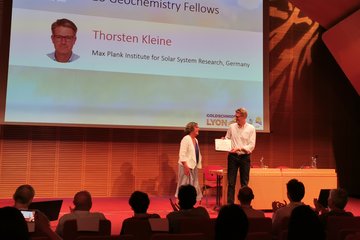Alle Typen
1.
Zeitschriftenartikel
The European Solar Telescope. Astronomy and Astrophysics 666, S. A21 (2022)
2.
Zeitschriftenartikel
Stokes diagnostics of simulated solar magneto-convection. Astronomy and Astrophysics 469, S. 731 - 747 (2007)
3.
Zeitschriftenartikel
A solar surface dynamo. Astronomy and Astrophysics 465, S. L43 - L46 (2007)
4.
Zeitschriftenartikel
Magnetoconvection in a sunspot umbra. Astrophysical Journal 641 (1), S. L73 - L76 (2006)
5.
Zeitschriftenartikel
Magnetic flux in the internetwork quiet Sun. Astronomy and Astrophysics 436, S. L27 - L30 (2005)
6.
Zeitschriftenartikel
Stokes diagnostics of simulations of magnetoconvection of mixed-polarity quiet-Sun regions. Astronomy and Astrophysics 442, S. 1059 - 1078 (2005)
7.
Zeitschriftenartikel
On the effect of photospheric magnetic fields on solar surface brightness: Results of radiative MHD simulations. Memorie della Societa Astronomica Italiana 76, S. 842 - 849 (2005)
8.
Zeitschriftenartikel
Simulations of magneto-convection in the solar photosphere: Equations, methods and results of the MURaM code. Astronomy and Astrophysics 429, S. 335 - 351 (2005)
9.
Zeitschriftenartikel
The Sun - a ball of electrically well-conducting gas. inSIDE - Innovatives Supercomputing 2 (1), S. 4 - 5 (2004)
10.
Zeitschriftenartikel
On the origin of solar faculae. Astrophysical Journal 607, S. L59 - L62 (2004)
11.
Zeitschriftenartikel
G-band spectral synthesis and diagnostics of simulated solar magneto-convection. Astronomy and Astrophysics 427, S. 335 - 343 (2004)
12.
Zeitschriftenartikel
Effects of non-grey radiative transfer on 3D simulations of solar magneto-convection. Astronomy and Astrophysics 421, S. 755 - 762 (2004)
13.
Zeitschriftenartikel
Approximations for non-grey radiative transfer in numerical simulations of the solar photosphere. Astronomy and Astrophysics 421, S. 741 - 754 (2004)
14.
Zeitschriftenartikel
On the fractal dimension of small-scale magnetic structures in the Sun. Astronomy and Astrophysics 409, S. 1127 - 1134 (2003)
15.
Zeitschriftenartikel
Why solar magnetic flux concentrations are bright in molecular bands. Astrophysical Journal 597, S. L173 - L176 (2003)
16.
Zeitschriftenartikel
Studying magneto-convection by numerical simulations. Astron. Nachrichten 324, S. 399 (2003)
17.
Zeitschriftenartikel
Generation of bisymmetric magnetic fields in galaxies with tidal interaction. Astronomy and Astrophysics 374, S. 36 - 41 (2001)
18.
Buchkapitel
Simulation of solar radiative magneto-convection. In: Analysis and Numerics for Conservation Laws, S. 107 - 136 (Hg. Warnecke, G.). Springer Verlag, Berlin (2005)
19.
Buchkapitel
Simulation of solar magneto-convection. In: High Performance Computing in Science and Engineering: Transactions of the Second Joint HLRB and KONWIHR Result and Reviewing Workshop, S. 431 - 442 (Hg. Wagner, S.; Hanke, W.; Bode, A.; Durst, F.). Springer, Berlin (2004)
20.
Konferenzbeitrag
Simulations of solar pores. In: Proceedings of the 11th European Solar Physics Meeting - The Dynamic Sun: Challenges for Theory and Observations, 11-16 September 2005 (Hg. Danesy, D.; Poedts, S.; De Groof, A.; Andries, J.). ESA Publ. Div., Noordwijk (2005)











